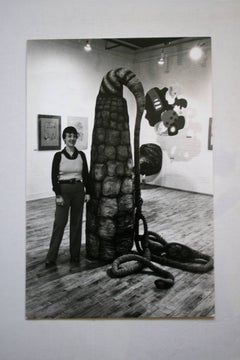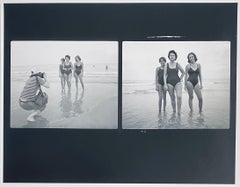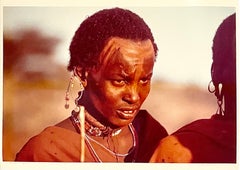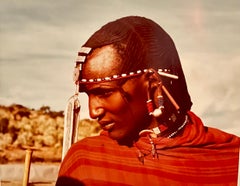Want more images or videos?
Request additional images or videos from the seller
1 of 8
Fred W. McDarrahGillian Bradshaw Smith in Studio1972
1972
$1,200List Price
About the Item
- Creator:Fred W. McDarrah (1926, American)
- Creation Year:1972
- Dimensions:Height: 19.5 in (49.53 cm)Width: 13 in (33.02 cm)
- Medium:
- Movement & Style:
- Period:
- Condition:
- Gallery Location:Surfside, FL
- Reference Number:1stDibs: LU38210738132
About the Seller
4.9
Platinum Seller
Premium sellers with a 4.7+ rating and 24-hour response times
Established in 1995
1stDibs seller since 2014
1,815 sales on 1stDibs
Typical response time: 1 hour
Authenticity Guarantee
In the unlikely event there’s an issue with an item’s authenticity, contact us within 1 year for a full refund. DetailsMoney-Back Guarantee
If your item is not as described, is damaged in transit, or does not arrive, contact us within 7 days for a full refund. Details24-Hour Cancellation
You have a 24-hour grace period in which to reconsider your purchase, with no questions asked.Vetted Professional Sellers
Our world-class sellers must adhere to strict standards for service and quality, maintaining the integrity of our listings.Price-Match Guarantee
If you find that a seller listed the same item for a lower price elsewhere, we’ll match it.Trusted Global Delivery
Our best-in-class carrier network provides specialized shipping options worldwide, including custom delivery.You May Also Like
5PTZ Boogie by street art photographer boogieREZ - REZ ONES, layered photography
Located in Jersey City, NJ
5PTZ Boogie by street art photographer boogieREZ - REZ ONES, layered photography
A layered portrait photograph of a graffiti writer (BOOGIErez aka Riiisa Boogie) standing perpendicu...
Category
2010s Street Art Color Photography
Materials
Metal
Price Upon Request
H 16 in W 20 in D 0.75 in
Black Hippie with Blond Afro, Washington Square Park - Henri Ghent Black Curator
By Mitchell Funk
Located in Miami, FL
In 1969, weekends at Bethesda Fountain were a gathering place for the radical, glamorous, and hip people of the time. Abbie Hoffman and Jerry Rubin were regular speakers there. Po...
Category
1960s Street Art Portrait Photography
Materials
Inkjet, Archival Ink, Archival Paper, Archival Pigment
Spiritual Hare Krishna Central Park, Consciousness is the Original Energy
By Mitchell Funk
Located in Miami, FL
In the early 1970s, Central Park was a center for celebrations and protests. In his image, the Hare Krishnas who are a mystical sect of Hinduism are capt...
Category
1970s Street Art Figurative Photography
Materials
Archival Ink, Archival Paper, Archival Pigment
Figures on the Steps of Bryant Park with Caravaggio Light
By Mitchell Funk
Located in Miami, FL
The ephemeral nature of fleeting light is captured in Kodachrome in this early color photograph taken in 1971.
The work is signed, dated, and numbered 3/15 lower right recto, other s...
Category
1970s Street Art Landscape Photography
Materials
Archival Pigment, Archival Ink, Archival Paper
D. Straker bei der Arbeit (Muralist, Neon, Glow, Graffiti, Street Art)
By Albrecht Fuchs
Located in Kansas City, MO
Albrecht Fuchs
Drew Straker at Work
Giclee on heavy Baryta Rag
2018
24.01 x 18.5 inches (61 x 47 cm)
Edition: 20 - BAT (respectively "Archive")
Signed, da...
Category
2010s Street Art Portrait Prints
Materials
Rag Paper, Giclée
$377 Sale Price
46% Off
H 24.01 in W 18.5 in
Texas, Portrait Photography, Country Music Singer Willy Nelson, 3 prints
By Leonard Freed
Located in New york, NY
Willy Nelson, 1993 by American photographer Leonard Freed is a series of (3) photographs, gelatin silver press RC prints, which are each signed verso (bac...
Category
1960s Contemporary Black and White Photography
Materials
Silver Gelatin, Photographic Paper, Photographic Film
Elizabeth Taylor, Hollywood Star 1950s on Film Set, Black and White Photography
By Burt Glinn
Located in New york, NY
Burt Glinn photographed one of the most highly-paid celebrity actresses, Elizabeth Taylor, 1959 on set during the filming of "Suddenly Last Summer". In the candid photo, he captures ...
Category
1950s Contemporary Portrait Photography
Materials
Silver Gelatin, Photographic Paper, Photographic Film
England, UK, London, Black and White Photo '60s Pop Star and Her Agent, Twiggy
By Burt Glinn
Located in New york, NY
Twiggy with her Manager, 1966 by Burt Glinn is a 10" x 8" gelatin silver press print from the 1960s. Magnum stamps from the period on verso (back of photo). Top Model Twiggy and her ...
Category
1960s Contemporary Portrait Photography
Materials
Photographic Paper, Silver Gelatin, Photographic Film
Cuba, Havana, Two Black and White Photographs, Waiting for Fidel Castro
By Burt Glinn
Located in New york, NY
Waiting for Fidel Castro, 1959 by American photographer Burt Glinn is a series of (2) photos, each photo is 9.5" x 12” - they are gelatin silver RC press prints, authenticated by the...
Category
1950s Contemporary Black and White Photography
Materials
Silver Gelatin, Photographic Film, Photographic Paper
$2,200
H 9.5 in W 12 in
Hugh Hefner, Vintage 1960s Black and White Photography of Playboy Magazine
By Burt Glinn
Located in New york, NY
A black-and-white 12" x 8" vintage photograph of Editor-in-chief Hugh Hefner checking proofs for Playboy magazine, 1966 by Burt Glinn. A historical photo...
Category
1960s Contemporary Black and White Photography
Materials
Photographic Paper, Silver Gelatin, Photographic Film
More From This Seller
View AllGillian Bradshaw Smith in Studio
By Fred W. McDarrah
Located in Surfside, FL
Gillian was born in India in 1933. Her British parents were part of the twilight of the British Raj.
Gillian completed her secondary education and entered The University of Reading, England to study Fine art and painting, a five year study.
She worked in Dallas, Texas making paintings, creating embroidered wall hangings and teaching special classes. Her work was shown at the Contemporary Gallery.
The art gallery that gave her her most important one man shows was Cordier & Ekstrom on Madison Avenue in New York. Headed by Arne Ekstrom a well known art dealer who showed many noted artists in his gallery including, Isamu Noguchi, Romare Bearden, Richard Lindner, Marcel Duchamp and Man Ray he also fostered the talents of younger artists such as Marvin Israel, Anton Van Dalen and Nancy Grossman...
Category
1970s Street Art Portrait Photography
Materials
Photographic Paper, Silver Gelatin
Vintage Silver Gelatin Photograph Print, Girls on a Beach Photo, Two Man Show
Located in Surfside, FL
Richard Lebowitz, b. 1937, American, (RISD Faculty 1964-1995, Photography; Professor Emeritus)
Tom Young, b. 1951, American, (RISD MFA 1977, Photography)
TIT...
Category
1980s American Modern Black and White Photography
Materials
Photographic Paper, Silver Gelatin
Rare Vintage Color C Print Photograph African Maasai Warrior Chromogenic Photo
By Carol Beckwith
Located in Surfside, FL
Carol Beckwith, (American, b. 1945),
Maasai Portrait
Chromogenic print on paper, from Beckwith's book "Maasai" (1980),
Hand signed in pencil, dated and titled with name of sitter ...
Category
1970s Contemporary Color Photography
Materials
Photographic Paper, C Print
Rare Vintage Color C Print Photograph African Maasai Warrior Chromogenic Photo
By Carol Beckwith
Located in Surfside, FL
Carol Beckwith, (American, b. 1945),
Maasai Portrait
Chromogenic print on paper, from Beckwith's book "Maasai" (1980),
Hand signed in pencil, dated and titled with name of sitter ...
Category
1970s Contemporary Color Photography
Materials
Photographic Paper, C Print
Faces, Vintage Color Photograph Digital Photo Collage Print Asian American
By Emily Cheng
Located in Surfside, FL
This was from Muse X publishers. It came in a plastic bag signed Emily Cheng. (the plastic bag is not included) It is on Fuji crystal photo paper. It depicts two Asian faces in a cubist, fractured way, with a woman (or man) holding a photograph over his/her face. it is marked proof NFS and is not signed or numbered.
Emily Cheng (born in New York City, in 1953) is an American artist of Chinese ancestry. She is best known for large scale painting with a center focus often employing expansive circular images radiantly colored, radially composed.
Cheng received her BFA in 1975 from the Rhode Island School of Design and attended the New York Studio School. Cheng has exhibited widely in the US and in Asia. In 2011, Cheng created Charting Sacred Territories, an exhibition exploring world religions which opened in the Museum of Contemporary Art Taipei (MOCA) , Taiwan (2011) and traveled to Hanart TZ Gallery in (2015),
Shenzhen Art Museum, Shenzhen, China, (2015) and in Europe at the Palais Liechtenstein Feldkirch, Austria (2019).
Cheng has had numerous solo shows in the US and in Asia and is represented by Hanart TZ Gallery in Hong Kong. In 2007, Timezone 8 published a monograph of Emily Cheng titled, Chasing Clouds, a decade of studies, with essays by Kevin Powers and Johnson Chang. Emily Cheng has lived and worked in New York City since 1977 and teaches Asian Art History at the School of Visual Arts. Influenced by a wide array of eastern and western artists including Van Gogh, Gauguin, Manet and Giacometti as well as de Kooning, early Philip Guston and Jackson Pollock. Nicolas Carone...
Category
1990s Conceptual Portrait Photography
Materials
Photographic Paper, C Print
Gianfranco Gorgoni Vintage Photograph Andy Warhol in Leather Factory Photo Print
Located in Surfside, FL
Large photograph, Andy Warhol at the factory
unsigned
Dimensions: 20" by 16"
Bears a pencil inscription Gianfranco Gorgoni verso
Gianfranco Gorgoni (1941 – 2019) was an Italian ph...
Category
20th Century Pop Art Black and White Photography
Materials
Photographic Paper



